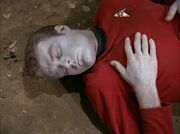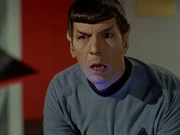m (→Resuscitation: lk update) Tag: apiedit |
m (Robot: Automated text replacement (-{{at|xx}} +{{multiple}})) Tag: apiedit |
||
| Line 1: | Line 1: | ||
| − | {{ |
+ | {{multiple}} |
[[File:Hiren_consumed_by_thalaron_radiation.jpg|thumb|The death of [[Praetor]] [[Hiren]]]] |
[[File:Hiren_consumed_by_thalaron_radiation.jpg|thumb|The death of [[Praetor]] [[Hiren]]]] |
||
{{aquote|Every life comes to an end when time demands it. Loss of life is to be mourned, but only if the life was wasted.|Spock|2237|Yesteryear}} |
{{aquote|Every life comes to an end when time demands it. Loss of life is to be mourned, but only if the life was wasted.|Spock|2237|Yesteryear}} |
||
Revision as of 17:21, 29 December 2016
(covers information from several alternate timelines)

Death is the permanent end of all life functions in a lifeform (or part of a lifeform in the case of tissue damage). It can also mean the absence of life or state of being dead. Many cultures address this process as it applies to sentient beings in spiritual terms, including the holding of wakes, memorials, and funerals following the death of an individual.
In 2365, Nagilum, in the guise of Data, asked Captain Jean-Luc Picard what death is. According to Picard there are two contemporary philosophies. One is the belief that death is the transformation into an indestructible and unchanging form. According to this belief the purpose of the entire universe is to then maintain that form in an afterlife in an Eden-like place. The other, contrary belief, is that death is simply blinking into nothingness. Picard himself believed that the existence of lifeforms is part of a reality beyond what is currently understood as reality and therefore both philosophies are insufficient. (TNG: "Where Silence Has Lease")
Death is sometimes perceived as an event that is common to all living things. In 2366, Captain Jean-Luc Picard used death and his own mortality as a way to show Nuria and her people that he was no different than they were, and certainly not a god they named "the Picard". (TNG: "Who Watches The Watchers")
According to Apollo, the race of the Greek gods was immortal, but also for them there was a point of no return. As their species could alter their form, it was possible for them to spread so thin that they would disappear from existence. Apollo poetically described this event as returning to the cosmos on the wings of the wind. Apollo was the last of the gods to die in 2267. (TOS: "Who Mourns for Adonais?")
Sargon considered himself dead although his mind was stored and active in energy-form inside a receptacle. He described the final destruction of his consciousness as departing to oblivion. (TOS: "Return to Tomorrow")
The Borg Collective considered death to be an irrelevant concept in their philosophy. (TNG: "The Best of Both Worlds") When a drone was damaged beyond repair, it was simply discarded. All of the drones experiences and memories lived on inside the collective consciousness. This was considered immortality by the Borg. (VOY: "Mortal Coil")
Artificial lifeforms can cease functioning through induced self-destruction. (TOS: "The Changeling")
Death may also be seen as a personification, attributed to a single entity, figure, or symbol. In this form, Death is known by many names, one of the more common being the "Grim Reaper". In 2370, the USS Enterprise-D encountered an alien probe that began to transform the Enterprise into an alien city, complete with hieroglyphic symbols, one of which was the symbol for Death (TNG: "Masks"). In 2267, Lazarus equated his parallel universe counterpart as "Death" and "Anti-Life" (TOS: "The Alternative Factor"). Neelix (and possibly other Talaxians) also have a concept of a "specter of death" (VOY:"The Cloud", "Jetrel")
In 2369, while explaining the nature of linear time to the Prophets, Commander Benjamin Sisko also explained the concept of death, stating that Jennifer Sisko was a most important part of his existence, but that he had "lost her some time ago." The Prophets, however, showed him that he spent much time in his mind dwelling on Jennifer's death, reliving his tragic experience on the USS Saratoga, that he "existed" there, something that was most certainly not linear. (DS9: "Emissary")
Many cultures considered death to be something welcomed, not feared. These included Klingons, whose culture put a high premium on honorable death, and the Vaadwaur, whose children were taught to fall asleep each night imagining different ways to die. (VOY: "Dragon's Teeth")
Resuscitation
For most lifeforms, death is a permanent state. However, sometimes resuscitation is possible:
- In 2259 of the alternate reality, Leonard McCoy used Khan Noonien Singh's blood to revive a dead tribble, and then James T. Kirk, who had died from radiation poisoning after reactivating the USS Enterprise's warp core. (Star Trek Into Darkness)
- In 2267, Montgomery Scott was killed by the Nomad probe. Nomad subsequently "repaired the unit Scott". (TOS: "The Changeling")
- In the same year, Leonard McCoy was killed by a knight's lance, in an environment that created reality from people's thoughts. McCoy's resurrection was brought about by the power which created the knight in the first place, after Kirk realized what was occurring. (TOS: "Shore Leave")
- In 2285, Spock experienced death, but with his katra having been placed into Leonard McCoy and his body regenerated on the Genesis Planet, he was able to live again. (Star Trek III: The Search for Spock)
- Tasha Yar killed Yareena with a poisoned, spiked weapon. Dr. Crusher revived her. The details of how exactly this was achieved weren't described. (TNG: "Code of Honor")
- The Kobali were capable of reanimating dead lifeforms in order to procreate their species, however the reanimated corpse would have a limited memory of his or her true life. (VOY: "Ashes to Ashes")
- Species 149 were medically advanced and had the ability to reanimate the dead. They were assimilated by the Borg, allowing the Borg to reanimate a drone as much as 73 hours after death. Neelix was also brought back from being dead using this technique after Seven of Nine proposed it as a medical treatment, but as his death did not match his culture's beliefs regarding an afterlife, he was profoundly disturbed by the experience. (VOY: "Mortal Coil")
- Data noted that his off-switch provided for an experience comparable to death, albeit one that permitted a simple resurrection. (TNG: "The Schizoid Man")
- In 2369, upon his death, Kobliad criminal Rao Vantika transferred his consciousness to Doctor Julian Bashir and continued living in Bashir. (DS9: "The Passenger")
Appendices
Quotes on Death
"He's dead, Jim."
- - Leonard McCoy (various)
"How we deal with death is at least as important as how we deal with life..."
"Today is a good day to die."
"...this was the day that I lost Jennifer. I don't want to be here."
"Then why do you exist here?"
- - Benjamin Sisko and a Prophet in Jennifer's form, on a replication of the USS Saratoga (DS9: "Emissary")
Related topics

A dead crewman
- After death
- Causes of death
- Casualty reports
- Casualty lists
- Bajoran Militia casualties
- Civilian casualties
- MACO casualties
- Mirror universe casualties
- Starfleet casualties (22nd century | 23rd century | 24th century)
- Redshirt
- Other
Additional references

Spock senses the death of the Vulcan crew of the USS Intrepid
- Episodes:
- ENT: "Dead Stop"
- TNG: "The Bonding"
- TNG: "Half a Life"
- DS9: "The Storyteller"
- DS9: "'Til Death Do Us Part"
- DS9: "To the Death"
- DS9: "Wrongs Darker Than Death or Night"
- VOY: "Death Wish"
- VOY: "Coda"
- VOY: "Barge of the Dead"
- Movies:
- Novels:
- Comics:
